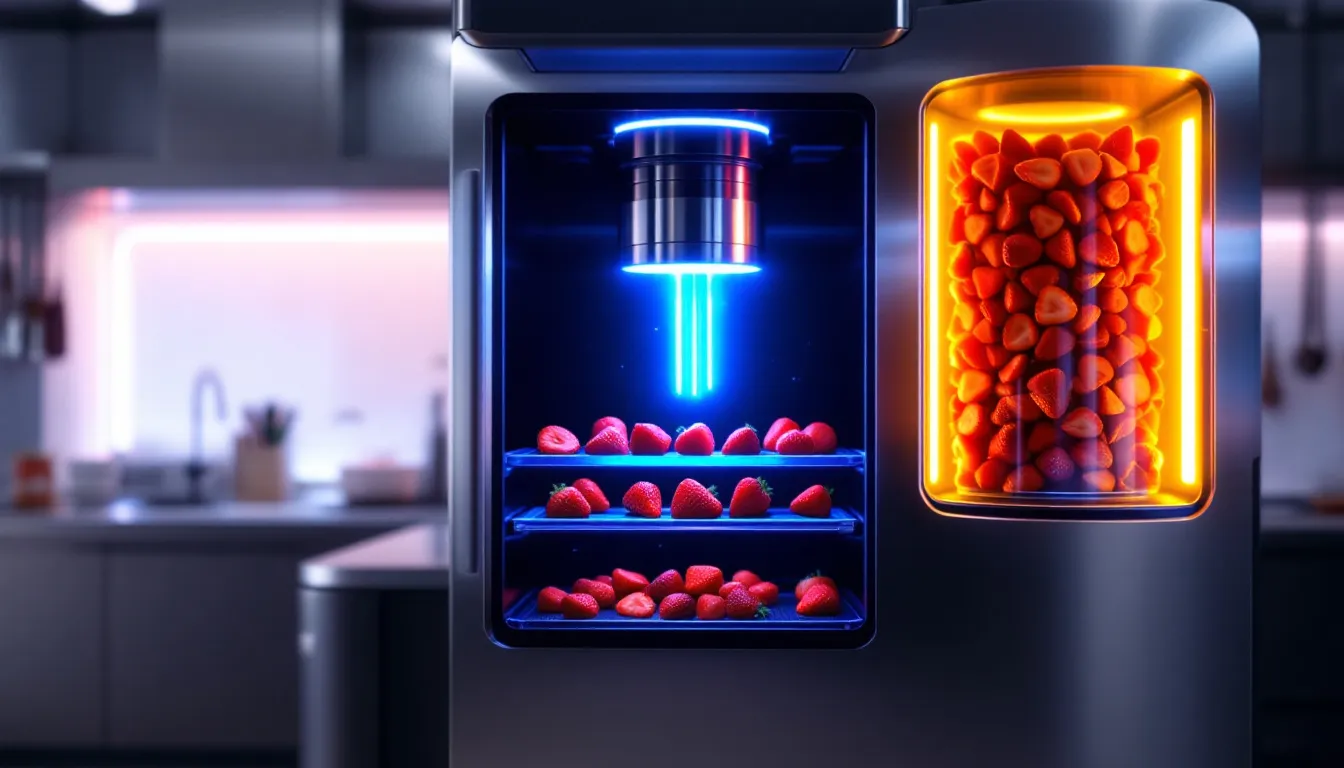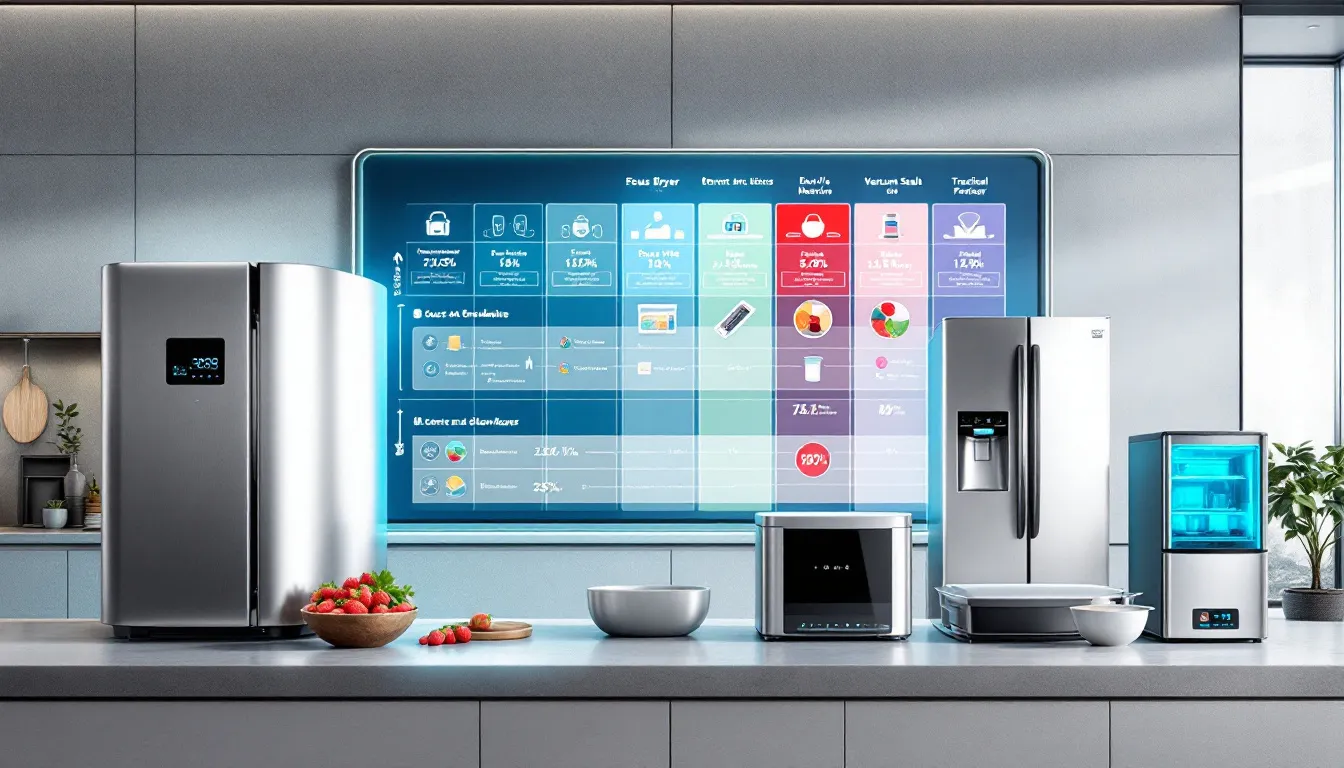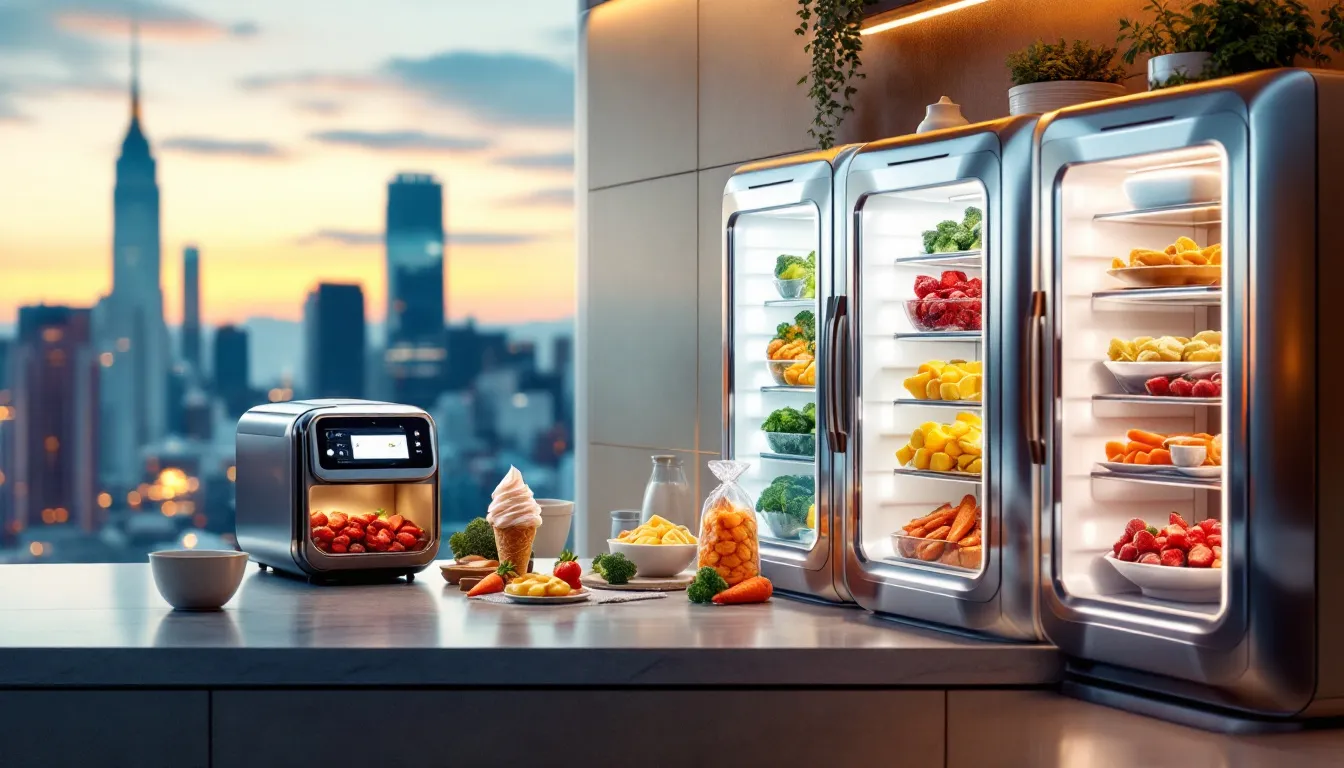Top Tips for Choosing the Best Home Freeze Dryer
A freeze dryer removes moisture from food, preserving it for years while keeping its nutrients intact. Want to know why you should get one? This guide covers how freeze dryers work, their benefits, types available, and key features to look for.
Essential Insights
-
Freeze drying is an efficient food preservation method that maintains nutritional quality through a process of sublimation, involving phases like preparation, freezing, and drying.
-
Investing in a home freeze dryer can save money by reducing food waste, allowing bulk purchases, and providing nutritious, long-lasting food options.
-
When choosing a freeze dryer, key features to consider include vacuum pump quality, temperature control, capacity, and programmable settings for optimal results.
Understanding the Freeze Drying Process

Freeze drying represents a captivating method of food preservation that not only extracts moisture but also safeguards the original structure and nutritional integrity of the food. It unfolds through four pivotal stages: initial preparation, solid freezing, primary drying, and concluding secondary drying. The initial step involves pre-freezing items to expedite subsequent phases.
During the primary stage of freeze-drying, the frozen state transitions directly into gas via sublimation—skillfully skipping over the liquid phase. This remarkably efficient process ensures foods retain their authentic nutritional value including vital vitamins and enzymes. Imagine relishing a freeze-dried apple brimming nearly with its full spectrum of vitamin content for an uncompromised healthy treat.
Finally, there is secondary drying where upwards of 95% humidity is stripped away from these edibles allowing storage without cooling systems while robustly deterring bacteria or mold proliferation. Apprehension around this meticulous procedure aids in selecting an appropriate freeze dryer suited to one’s needs such as ensuring longevity in emergency rations or preserving bountiful garden yields effectively informed by knowledge on how each aspect impacts overall food quality during dry freezing processes.
Comparing Freeze Drying to Other Preservation Methods

When evaluating freeze drying against alternative preservation techniques, its advantages are evident. Approximately 90-97% of the original nutritional content is preserved through freeze drying, outperforming methods such as dehydration by a notable margin. Consequently, foods that have been freeze dried maintain much of their nutritional benefits and provide a more nutritious choice.
In terms of longevity, foods that undergo the process of freeze drying surpass both canned and dehydrated counterparts in shelf life expectancy. They can be stored for an extended duration without any significant decline in quality. These items also retain their authentic shape and feel post-freeze-drying, which not only makes them appealing to look at, but also facilitates straightforward rehydration processes. Freeze-dried strawberries serve as a prime example. They closely resemble fresh strawberries both aesthetically and taste-wise, even after several months on the shelf.
Despite needing specific apparatuses which may result in higher costs than other preservation strategies, investing in the technique of freeze drying proves valuable due to its superior efficacy in preserving nutrients, extending lifespan on shelves while sustaining food’s initial caliber. In contrast to simpler and less expensive dehydration units available commercially which cannot match this level of nutrient conservation or textural integrity following treatment.
Why Invest in a Home Freeze Dryer?
Purchasing a freeze dryer for home use could significantly transform how you manage your food. The allure of substantial savings is one major motivation, as bulk buying coupled with home freeze drying can lead to decreased grocery bills and lessened food waste. A Harvest Right freeze dryer distinguishes itself by delivering higher quality dried foods along with expedited drying cycles, providing optimal outcomes consistently.
The capabilities of a home freezer don’t stop at cost-efficiency. They unlock new possibilities in the kitchen. Imagine preparing custom-made dried fruits for hiking adventures or preserving an abundance of seasonal vegetables for consumption throughout the year. There’s potential profit in creating sought-after items like freeze-dried candy to sell.
Despite appearing expensive initially, the investment into a home freezer yields considerable returns both monetarily and practically over time. It empowers you to not only extend the life of produce from your own harvest, but also ensures access to wholesome snacks whenever desired – showcasing its multifaceted utility that ultimately recoups its initial cost.
Pros and Cons of Owning a Freeze Dryer
Possessing a freeze dryer comes with its set of pros and cons. On the upside, these dryers contribute to less food wastage by enabling extended storage periods while maintaining the nutritional content of foods. They are relatively economical in terms of energy use, averaging around $2.03 per cycle.
On the flip side, several negative aspects should be taken into account. The upfront cost for acquiring a freeze dryer is substantial, often falling between $3,000 and upwards of $6,000. They also demand significant space within your kitchen area, which could be inconvenient for those with spatial limitations. To take up room, running a freezer dryer can lead to an uptick in electricity usage that may reflect as increased power bills.
Despite some drawbacks, numerous households regard having a freeze dryer as more advantageous than not. Its ability to preserve diverse varieties of foods over extensive durations along with prospective savings on costs contributes greatly towards its perceived household value.
Types of Freeze Dryers Available

Freeze drying is an exciting and diverse field, with a multitude of freeze dryer options to match any requirement. Whether you are engaging in the process for personal projects or larger-scale endeavors, there’s a suitable size and type available — ranging from compact units perfect for enthusiasts to expansive models that cater to commercial ventures involved in drying large amounts of food.
For those just venturing into the world of freeze drying, a medium-sized freezer dryer presents an excellent balance. It provides enough capacity to dry sizable quantities while remaining manageable for residential use. Conversely, if your aspirations include processing greater volumes or perhaps initiating a modest business venture, opting for one of the more extensive models might be advisable.
Specialists seeking precision during their laboratory applications can also find solace in specialized laboratory freeze dryers tailored specifically towards their sophisticated requirements. These lab-specific machines facilitate meticulous management throughout the freezing and drying stages—ensuring optimal results—and come in four distinct sizes enabling users easily identify the right freeze dryer tailored perfectly for their objectives without compromise.
Key Features to Look for in a Freeze Dryer
Choosing an appropriate freeze dryer entails careful examination of various critical elements. The excellence of the vacuum pump is paramount, as it plays a vital role in effectively eliminating moisture during the drying process. Seek out freeze dryers that can achieve pressures as low as 0.20 mBar to ensure thorough drying.
Controlling the temperature precisely is equally crucial when selecting a freeze dryer. It must have the capability to maintain temperatures at least 15 to 20 degrees below what’s needed for freezing your specific food items, maintaining them securely frozen during freezing and vacuum stages. Assess how much food you can accommodate by calculating capacity based on both the number of trays included and their collective surface area.
Having programmable options allows fine-tuning throughout different phases such as setting shelf temperatures and regulating vacuum strength—this contributes significantly towards optimizing consistency in results from batch to batch within your desired timeframe. Fast processing models are advantageous too: those completing cycles within merely six to eight hours offer greater efficiency for users with high-volume demands or commercial needs.
Best Practices for Freeze Drying Food at Home

Optimize the performance of your home freeze dryer by following these essential guidelines. Initiate the drying process with pre-freezing, as it can shorten drying time and improve texture quality in freeze-dried products. Accomplish this by placing food items into a standard freezer for several hours prior to beginning the actual freeze drying.
It’s crucial to confirm that foods are thoroughly freeze-dried before storing them. Search for darkened areas which may suggest moisture presence since residual moisture could undermine both shelf life and food quality. Storing your dried foods correctly is vital. Keep them in containers that are impermeable to air and have minimal humidity levels to preserve their integrity and prolong storage duration.
When selecting produce like vegetables for freezing, opt for those that are fresh and succulent because they maintain their nutritional profile and flavor more effectively than older counterparts do not provide satisfactory outcomes after being frozen dryed at home thereby making sure you continuously achieve superior standards when producing dried foods through freezing techniques.
Common Foods to Freeze Dry
One of the joys of owning a home freeze dryer is the variety of foods you can preserve. Fruits like strawberries, blueberries, bananas, apples, mangoes, and pineapples are popular choices due to their natural sweetness and versatility. Imagine adding freeze-dried strawberries to your morning cereal or blending freeze-dried mango into a smoothie!
Vegetables are also excellent candidates for freeze drying. Peas, corn, carrots, green beans, bell peppers, and broccoli retain their color and flavor, making them perfect for soups, stews, and side dishes.
Meats like beef, chicken, turkey, and ham can be freeze-dried for meals or emergency provisions, providing a convenient protein source.
Dairy products such as cheese, yogurt, and even ice cream can be successfully freeze-dried, offering delicious and shelf-stable options. Whole eggs, egg whites, and yolks are also great for freeze drying, adding versatility to your cooking.
Don’t forget herbs and spices—freeze-dried basil, oregano, mint, garlic, and onion can enhance your dishes with fresh, robust flavors.
Where to Place Your Freeze Dryer
To ensure your freeze dryer operates at peak efficiency, position it in a location with ample airflow to avoid overheating. The appliance should rest on a sturdy surface that elevates it at least three feet above the ground for optimal functionality.
The ambient temperature where the freeze dryer is situated should be maintained between 50 and 75 degrees Fahrenheit. It’s important not to place the unit in confined spaces like corners or cabinets since this can impede air circulation and raise the risk of overheating. Make sure that there is a straight vertical path for the drain hose which aids in avoiding operational drainage problems.
For electrical safety and performance reliability, situate your freeze dryer away from appliances that draw significant power on the same circuit. Select an area such as a basement or spare room—somewhere you can easily supervise its operation without being disturbed by noise—but steer clear of isolated structures like detached garages or outbuildings because frequent checks are necessary for proper functioning.
Real-Life Savings with a Freeze Dryer

Utilizing a home freeze dryer can culminate in substantial financial benefits. By extending the shelf life of excess fruits and vegetables, you are able to minimize food wastage, ensuring that every bit of your harvest is utilized. Purchasing large quantities of groceries and applying freeze-drying techniques enables you to take advantage of economies of scale, Diminishing grocery expenditures.
Though acquiring a home freeze dryer may seem costly at first glance, these devices pay for themselves over time due to continuous savings. For instance, meals prepared with a home freeze-dryer could cost as little as $3.25 each—a stark contrast to pricier commercial ready-made alternatives—reflecting significant savings on meal expenses alone. Numerous households discover that they can recoup their initial outlay through the reductions afforded by decreasing food waste and opting for bulk buying within just several years.
Imagine the comfort that stems from stocking up on durable, nutrient-rich meals while concurrently conserving funds for future needs. The economic advantages offered by incorporating home drying methods into food preservation routines present an economically prudent choice for any family considering long-term planning and investment in their provisions.
Maintenance and Care for Your Freeze Dryer
Ensuring that your freeze dryer remains operational for an extended period necessitates regular maintenance. Cleaning the condenser, internal chambers, and shelving after every use is imperative to keep it functioning properly by preventing any buildup of residues.
For oil-sealed models of vacuum pumps within the system—a critical element—routine oil changes are vital. The recommended frequency for changing the pump’s oil is once every 2,000 hours of operation. Conducting annual functional inspections on the refrigeration unit can preemptively address issues before they escalate into more significant problems.
In circumstances where components come in contact with acidic substances, utilizing neutralizing cleaners safeguards against corrosive damage to your freeze dryer. Calibrating temperature and pressure sensors regularly also maintains precise measurements which are essential in delicate processes. Documenting all performed maintenance activities meticulously offers a way to monitor performance consistently over time and ensure reliability across uses.
Customer Support and Warranty Considerations
When purchasing a freeze dryer, it is essential to consider the quality of customer support and warranty offerings. A minimum one-year manufacturer’s warranty is advisable for ensuring your investment remains secure. Harvest Right offers a 1-Year Limited Warranty on their freeze dryers with additional options available for extended coverage to Safeguard your purchase.
The level of customer service can greatly influence customer satisfaction with the product. Known for its exemplary customer care, Harvest Right boasts quick response times and has an extensive network of over 6,000 technicians ready to provide assistance. For swift assistance, customers are able to connect in approximately 15 seconds and receive answers within another half minute, leading to rapid resolution of any concerns that may arise.
Committing funds toward a home freeze drying system necessitates assurances regarding ongoing support and guarantee terms that back up the equipment’s performance. Accessing superior customer service coupled with an encompassing warranty elevates your experience when engaging in at-home freeze drying activities through enhanced confidence in both the longevity and dependability of your Harvest Right freezer dryer acquisition.
Quick Guide to Home Freeze Dryers
In summary, investing in a home freeze dryer opens up a world of possibilities for food preservation. By understanding the freeze drying process, you can make informed decisions about which foods to preserve and how to do it effectively. Whether you’re looking to save money, reduce food waste, or simply enjoy the convenience of long-lasting, nutritious meals, a home freeze dryer is a versatile and valuable tool.
We’ve explored the different types of freeze dryers available, highlighting the importance of key features like vacuum pump quality and temperature control. We’ve also provided best practices for freeze drying food at home and discussed the wide variety of foods that can be successfully freeze dried. From fruits and vegetables to meat and dairy products, the options are nearly endless.
Owning a freeze dryer comes with its own set of pros and cons, but the benefits often outweigh the drawbacks. With proper maintenance and care, your freeze dryer can provide years of reliable service. And with excellent customer support and warranty options available, you can invest with confidence. So why wait? Start your freeze drying journey today and enjoy the many benefits it brings.
What is the main advantage of freeze drying over other preservation methods?
The main advantage of freeze drying is that it keeps about 90-97% of the food’s nutrients while preserving its original shape, texture, and flavor.
It’s a great way to enjoy food that tastes good and is packed with nutrients!
How much does it cost to run a home freeze dryer?
Running a home freeze dryer usually costs about $2.00 to $3.00 a day in electricity, so it’s pretty affordable overall!
What types of foods can be freeze dried?
You can freeze dry all sorts of foods like fruits, veggies, meats, dairy, eggs, and even herbs and spices.
It’s a super versatile way to preserve your favorites!
How do I maintain my home freeze dryer?
To keep your home freeze dryer in top shape, make sure to clean the condenser, chambers, and shelves after each use. Change the vacuum pump oil regularly, and do yearly tests on the refrigeration system.
Regular calibration of the temperature and pressure sensors is also key!
Is it worth investing in a home freeze dryer?
Absolutely, a home freeze dryer can be a smart investment since it cuts down on food waste and saves you money in the long run by preserving food for longer.
You’ll be amazed at how much you can save on groceries!


Comments
Post a Comment